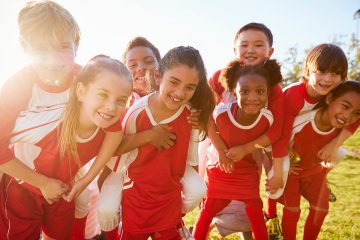Extracurricular activities that nurture a sense of belonging with peers appear to bolster preteen’s mental health, new research from the University of British Columbia suggests.
The study, recently published in the Journal of Youth and Adolescence, focused on students’ participation in different types of extracurricular activities in Grades 4 and 7, and how participation – or non-participation – over time was linked to their mental health.

Eva Oberle, assistant professor, school of population and public health
The researchers found that participating in team sports in particular provided benefits for mental health – more than non-participation in extracurricular activities and more than participation in individual activities, such as tutoring, music lessons and individual sports. Experiencing a stronger sense of peer belonging fully explained the positive relationship between participation in activities including team sports and better mental health.
Tracking participation in activities over time, the researchers also found that during middle childhood and early adolescence, young people tended to participate – or not participate – in the same combination of extracurricular activities, with little change over time. Youth who didn’t participate in extracurricular activities in Grade 4 but had joined activities including team sports by Grade 7 reported better mental health over time, which was attributable to a stronger sense of peer belonging.
“It’s a stronger sense of belonging to the peer group, not necessarily the activity itself, that seems to drive the mental health benefits of participating in activities that included team sports,” said lead author Eva Oberle, assistant professor in the school of population and public health and a researcher with the Human Early Learning Partnership.
“The results of our study shouldn’t be interpreted as ‘team sports are good’ and ‘individual activities – like tutoring or music classes – are not,’” she said. In fact, another recent UBC study found that high school students that engaged in school-based music programs, such as band or orchestra, had higher levels of academic achievement over time. “The key point is that extracurricular activities that allow children to establish meaningful relationships with their peers can support their positive mental health. Group activities like team sports may naturally do this, whereas other activities may need to deliberately integrate some additional strategies to better support peer connectedness.”
Extracurricular activities that allow children to establish meaningful relationships with their peers can support their positive mental health.
Eva Oberle
assistant professor, school of population and public health
“Because there are benefits of extracurricular participation, and participation and non-participation in extracurricular activities seems to relatively stable over time, we need to support young kids to get involved in activities early on,” Oberle added. “It’s important for communities to think about how they can make activities accessible for all children, ensuring fees aren’t a barrier and offering activities at accessible locations, for example on school grounds and right after school to make them accessible for children with working parents.”
For the study, scientists analyzed results from more than 10,000 students who participated in a province-wide survey administered in Grades 4 and 7 in 383 schools in 36 school districts across B.C. The Middle Years Development Instrument survey assesses psychological well-being and mental health, health, supportive relationships and use of out-of-school time. Mental health indicators included life satisfaction and optimism, anxiety and depressive symptoms; social connectedness was assessed through a sense of peer belonging.

Based on students’ self reports, researchers included four groups of extracurricular participations in their analysis. “Sports only” referred to students that predominantly participated in team and individuals sports “Individual activities” denoted students who predominately participated in individual sports, art, music and educational programs. The other subgroups were “non-participants” and “participation in all activities.”
This study differed from previous research of extracurricular activities and youth, which mostly focused on participation among older adolescents at one point in time only.
Oberle is now investigating different reasons for why non-participants don’t participate in extracurricular activities, and what they activities they do in their free time instead of extracurricular participation.
Oberle received funding from the Social Sciences and Humanities Research Council of Canada to carry out this research.